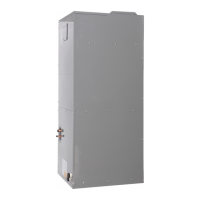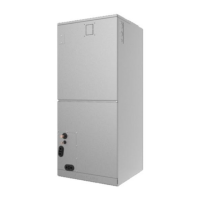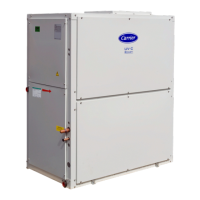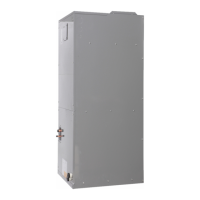13
ACB (Auxiliary Control Board) Interface The
ACB interface is a dry contact board, it can output up to four
signals controlling devices. Please refer to Fig. 14 for
connecting devices to the ACB interface board
LEGEND
ACB
—
Auxiliary control board
AUXH
—
Output for auxiliary heat
CTON
—
Output for cooling operation
FAN
—
Output for exhaust fan
HTON
—
Output for heating operation
MAX AMPS
1A
MAX VOLTAGE
24V
Fig. 14 — ACB Interface
.
START-UP
Pre-Start Check
Once installation is complete, make the
following pre-start checks:
1. All indoor and outdoor units are properly installed.
2. All piping and insulation is complete.
3. All electrical connections (both power and control) are
properly terminated.
4. All condensate drains are installed correctly.
5. The power supply is of the right voltage and frequency
.
6. The units are properly grounded in accordance with
cur
rent electrical codes.
7. Suction and liquid line service valves are in open
position.
System Operation Check Once the installation and
pre-start checks are completed, follow these steps:
1. Using remote controller, select
cooling or heating mode
to check the operation of the system.
2. While the system is in operation, check the following on
indoor unit:
a. Switches or buttons on the remote controller are
easy to
push.
b. Indicator light is showing normal operation and no
error is
indicated.
c. Swing mode of air louvers is working (if applicable to
unit).
d. Drain pump operation is normal (if applicable).
e. No abnormal vibration or noise is noticed.
3. While the system is in operation, check the following on
outdoor unit:
a. No abnormal vibration or noise is noticed.
b. Condenser fan is in operation.
c. Indicator light is showing normal operation and no
error is indicated.
NOTE: If the unit is turned off or restarted, there is a time
delay of 3 minutes for the compressor
to start from the time the
power is restored.
MAINTENANCE
CAUTION
When servicing or repairing this unit, use only factory-
approved service replacement parts. Refer to the rating
plate on the unit for complete unit model number, serial
number and company address. Any substitution of parts or
controls not approved by the factory will be at the owner’s
risk and may result in equipment damage.
CAUTION
To avoid equipment damage, do not attempt to reuse any
mechanical or electrical controllers that have been wet.
Replace defective controller.
Every 3 Months:
• Check the air filter condition. Clean or replace if
necessary.
Every 6 Months:
Follow 3-month maintenance schedule. In addition:
• Clean condensate tray with
suitable cleaning agent.
• Clean the grille and panel.
Every 12 Months:
Follow 6-month maintenance schedule. In addition:
• Be sure all electrical connections are se
cure.
• Check condensate pump operation.
• Check the heating and cooling action to confirm proper
op
eration.
INDOOR UNIT ADDRESSING
For proper system operation each indoor unit must have a
unique address set from 0 to 63. When setting an address by
remote controller the outdoor units, indoor units, and MDC
must be powered on. If “FE” is displayed on the LED screen or
display board this unit has no address. After setting all indoor
units’ addresses, turn off the power supply to all indoor units to
clear errors.
Indoor units’ addressing can be distributed automatically in
the
heat pump system. When dip switch “S6” on the outdoor
units main PCB board is set to 00 (default set in factory) indoor
unit’s are set for auto-addressing. When powering on for the
first time it takes 6 minutes or more to finish auto-addressing
each indoor unit. The heat recovery system cannot accomplish
this function at this time.
Wireless Remote Controller (40VM900001)
(included with the outdoor unit)
Indoor unit
addressing can be performed using the wireless remote
controller. When using the wireless controller, the user must
maintain a line of sight with the receiver on the indoor unit. See
Fig. 15 for a description of the buttons
on the wireless remote.

